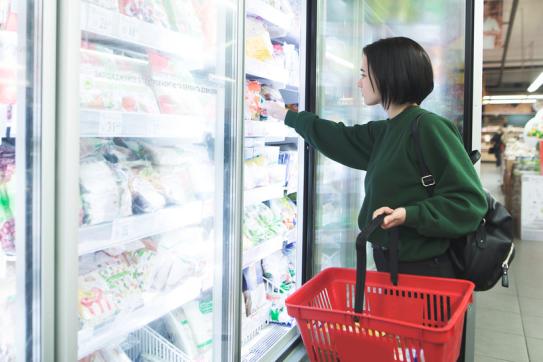In March, news of the COVID-19 virus and its potential to disrupt the everyday lives of millions of Americans began to spread to every region of the country.
As the media broadcasted government warnings that households should prepare to stay inside their homes, Americans reacted with their wallets. Stores soon saw shortages of toilet paper and disinfectants, while some people ate last meals at restaurants that were sure to close as social distancing became the norm.
In terms of household spending, March was a demarcation point between pre-and post-pandemic behavior.
According to a new working paper co-authored by professors R.A. Farrokhnia and Michaela Pagel along with Scott R. Baker of Northwestern University, Steffen Meyer of the University of Southern Denmark, and Constantine Yannelis of the University of Chicago, spending increased among Americans in the first half of March, followed by a sharp decrease as shelter-in-place orders began to become more common across the country.
Using nearly real-time, transaction-level data from bank accounts provided by Saverlife, a non-profit helping working families develop long-term savings habits and meet financial goals, the researchers tracked financial details from tens of thousands of Americans during March and April 2020 while having access to historical data from the same pool of users.
“With this dataset, we see anonymized people’s income, spending, and bank account balances,” says Pagel, the Roderick H. Cushman Associate Professor of Business.
According to Farrokhnia, Executive Director of Advanced Projects and Applied Research in Fintech at the Dean’s Office and teaching at the Economics Division, the speed with which the researchers collected and analyzed the data, as well as its demographic and partisan figures, could be of critical use to American lawmakers, who have in the past five weeks approved expansive relief packages aimed at households as well as businesses.
“The objective here is to provide data-backed insight and make policy recommendations that are very close to what’s been happening on the ground during this health and financial crisis,” Farrokhnia says. “It’s valuable to use lessons from prior crises, like 2008, but there are different dynamics playing out here, hence our research could be impactful given its scope and timeliness.”
Pagel notes that the research team will next be monitoring the effect of the US government’s disbursement of $1,200 to those who earned less than $75,000 after taxes in 2019.
“Will it be spent on new TVs or on rent payments?” Pagel says. “That makes a big difference in terms of how the economy will be stimulated.”
According to their data, household spending increased by 50 percent overall between February 26 and March 11, as households began to stockpile food and supplies. While spending on groceries remained strong through March 27, with a 7.5 percent increase from 2019, the second week of that month is when consumer behavior started to change.
“Between the news media and political conversation, discussion about the virus then reached an inflection point,” Farrokhnia says. “It’s like something just clicked in mid-March.”
After March 11, overall household spending as well as spending in restaurants dropped sharply. In addition, the researchers found that amount spent did not vary much across several demographics and political affiliations. This is not surprising, as schools and businesses closed throughout the US starting March 15.
“We collected data on the age, income, family, and location of households,” Pagel says. “We found some small differences for the various groups.”
The research found that between March 18 and 27, those under 30 years old cut back on spending by a smaller amount than older people, which the researchers tie to reports that younger individuals were more likely to ignore stay-at-home orders than older Americans.
“Millennials started stockpiling a bit later, but that makes sense,” Farrokhnia says. “They are more likely to be single, or have a partner and no children, and perhaps with less access to savings.”
During the same period, households with children saw overall declines in spending that were twice as fast as households without children, but those with larger families tended to spend more on groceries.
Farrokhnia and Pagel also found that in general, Democratic and Republican households demonstrated similar spending behavior during March.
Although the media tended to paint Democrats as more concerned with the virus, Republicans spent slightly more overall between February 26 and March 10.
“Democrats and Republicans, in the aggregate, acted similarly,” Farrokhnia says. “Some Republicans, for instance, spent more at restaurants, but then expenditures converged.”
Pagel says the intensity of news coverage could explain the similarity of behavior among households.
“It’s not something that only concerns people in New York,” Pagel says. “Everyone is affected by this and responded in similar ways.”
In the coming weeks and months, Farrokhnia and Pagel say they will continue to track the savings rate among households during the pandemic. In 2019, the Federal Reserve Bank issued findings noting that 4 in 10 Americans do not have $400 in savings to cover a minor, unexpected expense.
“I think this crisis might accelerate meaningful conversations about savings and saving habits,” he says.
As the economy continues to falter, Farrokhnia says that households spending and saving habits will continue to evolve, both in short-term and long-term ways that may or may not predictable. But the economic fallout could also leave a lasting impression on the psyches of those in their teens and early 20s.
“Literature shows that the generation that grew up during the Great Depression tended to save more and were more prudent with money,” Farrokhnia says. “Generation Z may also view this crisis as a life-changing event when it comes to how they manage their personal finances.”
The aforementioned working paper is entitled “How Does Household Spending Respond to an Epidemic? Consumption During the 2020 COVID-19 Pandemic,” and is available for download on NBER and fintech.gsb.columbia.edu.
